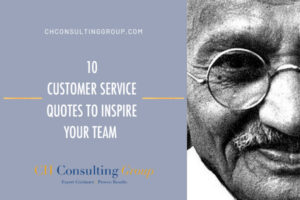It’s been estimated that a whopping $62 billion of business was lost last year due to poor customer service, which represents an increase of almost 50 percent from two years prior. That’s a scary thought. Worse yet is this statistic from a recent SuperOffice report: 80 percent of businesses believe they provide excellent customer service, while only 8 percent of customers agree. I hope you have already thought about the state of your company’s customer experience. If not, these numbers should motivate you, especially considering that the impact of customer experience is only going to continue to grow. Here are some of the top trends to watch in 2018:
Using Data to Personalize the Experience
According to a Dimension Data report, the No. 1 trend affecting contact centers in the coming years will be the personalization of services, which will be made possible by data analytics. By preemptively anticipating customers’ needs, companies can cater to their most important commodity: time. One day in the not-so-distant future, we’ll reminisce about how we used to be subjected to vast amounts of content that was not relevant to us in the form of things like TV commercials and spam.
A recent Salesforce study found that more than 70 percent of consumers expected brands to understand and anticipate their needs. Customers’ expectations to be treated as individuals with specific preferences is a fact of life now, and it will only become more so in the coming year. In order to deliver this hyper-personalization, companies must be able to leverage a deep understanding of customer preferences, which is where data analytics comes into play. You have to be able to gather customer information from every platform, channel and touch point in order to create a complete picture of your customer before you can provide a personalized experience.
The Opportunity to Differentiate
I know you are already familiar with the fact that customer experience will outpace product price and quality as the key competitive differentiator. But did you know that day has already arrived? Today, even if you don’t have the best product in your space, or your website doesn’t draw traffic like the big brands, if you improve your customer experience, people will like you and that will drive conversions more than anything else. Also consider the fact that many of your competitors are likely not investing in this area. According to Forrester research, while 72 percent of businesses say improving customer experience is their top priority, only 63 percent of marketers prioritize implementing technology that will help them reach this goal. This means that, with the right strategy, a company providing outstanding customer experience will quickly – and consistently – stand apart from competitors.
It’s also important to look for ways to reduce costs, systems, and people. Be aggressive about retiring parts of your legacy capability so you can free up money to invest and enable your digital capability.
The Ever-Present Omnichannel
In my work helping clients optimize – and in some cases, revolutionize – their cultures and processes in order to focus more squarely on customer experience, I have seen firsthand the challenges that arise when trying to connect disparate channels into a more cohesive consumer environment. Many times, this requires dismantling long-established silos, which although uncomfortable for many businesses, is imperative when it comes to delivering a seamless customer experience. Don’t be lulled into a false sense of complacency by thinking omnichannel is something only larger brands need to consider. In the coming year, a cohesive, consistent, effortless customer experience will be a requirement for success for businesses of all sizes, across all industries.
The Expansion of the Internet of Things
Most simply, the IoT refers to the ever-increasing number of devices connected to and communicating with one another over shared networks. More connected channels mean greater opportunities for businesses to gather and analyze consumer data in order to provide proactive customer experience. For example, one of consumers’ biggest frustrations – and a large number of inbound calls – is locating their deliveries. By sending regular status updates to customers’ smart devices, one major fashion retailer reduced delivery-related calls by 80 percent. The IoT is also transforming how we collect Voice of the Customer information by replacing or enhancing traditional surveys with rich, contextual data using things like mobile phone sensors. This combined experience feedback provides businesses with the opportunity to understand and interact with consumers in a whole new way.
AT CH Consulting Group, we work with clients in industries ranging from finance and energy, to pet supplies and fashion to better understand their customer experience in order to create strategies that support growth far into the future. For more information, contact me directly!
Read more:
An Insider’s View Part 1: The Current State of Contact Center Technology
An Insider’s View Part 2: The Current State of Contact Center Technology



